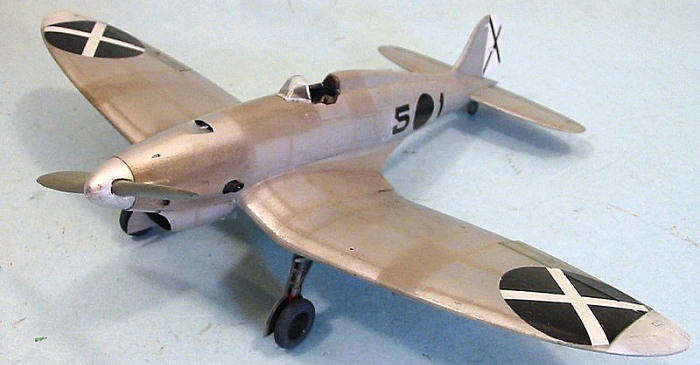
| KIT: | Rest 1/48 He-112v6 |
| KIT #: | ? |
| PRICE: | $70.00 MSRP |
| DECALS: | One option |
| REVIEWER: | Tom Cleaver |
| NOTES: | Resin kit |

| HISTORY |
In 1934, the He-112 was expected to be the new fighter of the Luftwaffe after the Technishes Amt of the Reichlufartsministerium (RLM) announced a competition for “sports plane” to fulfill the requirements of Rüstungsflugzeug IV for a single-place fighter. The initial requirements were not terribly difficult, asking for a top speed of 400 km/h at 6000 m (250 mph at 19,500ft), the ability to maintain such altitude for 20 minutes, with fuel for 90 minutes’ flight. The aircraft was to be armed with at least three 7.62mm machine guns with 1000 rounds each, or one 20 mm cannon with 200 rounds. Additionally, wing loading should be kept below 100 kg/m. The priorities were level speed, climb speed, and then maneuverability, in that order.
Heinkel was one of the most experienced aircraft companies in Germany, and was responsible for the Luftwaffe’s first fighter, the He-51; the company was the favorite to win the new competition. That Heinkel was expected to win was shown by the decision of the RLM that Heinkel would proceed to produce what was considered the most conventional of the four designs that were ordered, a low wing monoplane with open cockpit, low wing loading, and retractable landing gear, while Arado produced the Ar-80 - a much more basic design - and Focke-Wulf produced the Fw-159 parasol fighter with retractable landing gear. Almost no one paid attention to the fact the Bayerische Flugzeugwerke was producing what was effectively a single-seat version of its advanced Bf-108 4-seat sports plane.
The gear retraction system proved to be the Achilles heel of the Fw-159, which was complex and failure-prone, with the first two prototypes both lost because of gear failure. The Ar-80, which had fixed gear, never met its performance figures.
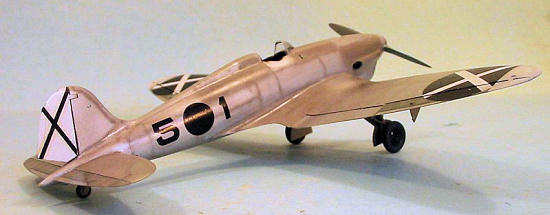 The He-112,which was easily
the most aesthetic of the four designs with its graceful elliptical wing and
tail surfaces which signified it as a design from Walter and Siegfried Günter,
turned out to be overweight and underpowered. Like their successful He-70 Blitz,
the He-112 was entirely metal, with a two spar wing and monocoque fuselage with
flush mounted rivets. The gear retracted outward from the low point of the gull
wing, resulting in a wide track that provided excellent ground handling. Its
open cockpit was included to biplane-experienced pilots more comfortable.
The He-112,which was easily
the most aesthetic of the four designs with its graceful elliptical wing and
tail surfaces which signified it as a design from Walter and Siegfried Günter,
turned out to be overweight and underpowered. Like their successful He-70 Blitz,
the He-112 was entirely metal, with a two spar wing and monocoque fuselage with
flush mounted rivets. The gear retracted outward from the low point of the gull
wing, resulting in a wide track that provided excellent ground handling. Its
open cockpit was included to biplane-experienced pilots more comfortable.
With the intended Junker Jumo 210 engine unavailable, the He 112 V1 was powered bu a 695 hp Rolls-Royce Kestrel Mk.II.S. Initial test flights revealed drag was much higher than expected, and that the plane was not going to be as fast as originally predicted.
The He-112 V2 flew November 16,1935, with a 640 hp Jumo 210C engine and three bladed prop. The Günter brothers had identified the large thick wing as the main culprit regarding drag, and the V2 was modified with a thinner clipped wing which was expected to improve the speed of the plane by 25 to 30 km/h (15 to 18 mph) and allow it to compete with the Bf-109,which was the fastest and best-performing of the four competitors. The He-112 V2 still couldn’t compete with the Bf-109 V2 which was also Jumo-powered.
The He-112 had better turn performance due to its larger wing, but the Bf-109 was faster at all altitudes and was considerably more agile with superior aerobatic abilities. During spin tests on March 2, 1936 the Bf-109 V2 had no problems while the He-112 V2 crashed.
With the announcement of full-scale production of the Supermarine Spitfire for the RAF, time became of the essence in choosing a new fighter. The Bf-109 V2 was much closer to a production standard than any of the He-112 prototypes, each of which was considerably different from the others. On Mary 12, 1936, the RLM announced that the originally-favored He-112 had lost the competition to the long-shot Bf-109, which was to be placed in quantity production as the Luftwaffe’s single engine day fighter immediately.
 In fact, the very
aesthetic beauty of the He-112 had also worked against it, since it would
require more man-hours to produce than the angular Bf-109. As a consolation,
Heinkel received an order for 15 He-112A-0 aircraft, pending further redesign
and development already proceeding, which would ultimately result in the
very-different He-112B.
In fact, the very
aesthetic beauty of the He-112 had also worked against it, since it would
require more man-hours to produce than the angular Bf-109. As a consolation,
Heinkel received an order for 15 He-112A-0 aircraft, pending further redesign
and development already proceeding, which would ultimately result in the
very-different He-112B.
By the fall of 1936, the Spanish Civil War had broken out and Hitler had determined to help the fascist rebels led by General Francisco Franco in their attempt to overthrow the democratically-elected Republican government of Spain. Within weeks of the arrival in Spain of He-51 fighters, they came up against the Polikarpov I-15 and I-16 fighters, which were superior on all counts to the German fighter. With the Legion Condor about to be forced to tuck its tail between its legs before it had really had a chance to fight, three prototype Bf-109s were sent to Spain in December 1936. Ernst Heinkel saw this as an opportunity to prove his fighter in combat, and obtained permission for the He-112 V6, which was armed with a single 20mm cannon firing through the airscrew hub, to be sent as a Kanonenvogel for evaluation in the role of ground attack. The Kanonenvogel was assigned to Versuchsjagdgruppe 88 within the Legión Cóndor to join the three V series Bf 109s in combat evaluation.
Oberleutnant Günter Radusch was assigned to fly the Kanonenvogel on December 9 at Tablada, where it joined the Ju 87As and Hs 123s already in service. On February 6, plane and pilot moved to Villa de Prado near Madrid, and were re-assigned to Jagdgruppe 88 at Almorox near Toledo in March.
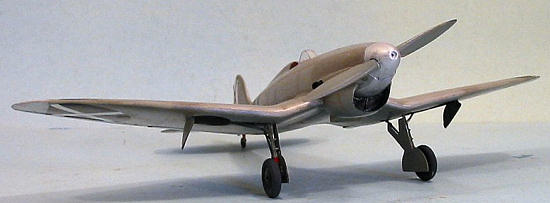 At Almorox, Oberleutnant
Wilhelm Balthasar learned a Republican armored train was approaching and talked
himself into the cockpit of the He-112 V6 by insisting he was a Heinkel test
pilot. After managing to get airborne, he found the train parked at the station
in Seseña and attacked. On his third pass a 20 mm shell hit the ammunition car
and the entire train exploded. On the way back to Almorox, Balthasar found an
armored car and set it on fire. Now famous, Balthasar was put in command of a
newly-formed combat group with the He-112 V6 and three He-45Cs. Over the next
few months, the He-112 V6 was flown by several pilots. On July 6, 1937,
Unteroffizier Max Schulze knocked out several armored cars. On July 19, with
Schulze in the cockpit, the engine seized during landing. Schultze walked away
from the crash but the He-112 V6 broke her back and was written off.
At Almorox, Oberleutnant
Wilhelm Balthasar learned a Republican armored train was approaching and talked
himself into the cockpit of the He-112 V6 by insisting he was a Heinkel test
pilot. After managing to get airborne, he found the train parked at the station
in Seseña and attacked. On his third pass a 20 mm shell hit the ammunition car
and the entire train exploded. On the way back to Almorox, Balthasar found an
armored car and set it on fire. Now famous, Balthasar was put in command of a
newly-formed combat group with the He-112 V6 and three He-45Cs. Over the next
few months, the He-112 V6 was flown by several pilots. On July 6, 1937,
Unteroffizier Max Schulze knocked out several armored cars. On July 19, with
Schulze in the cockpit, the engine seized during landing. Schultze walked away
from the crash but the He-112 V6 broke her back and was written off.
The He-112 V8, an earlier A series model with the larger DB600Aa engine, was sent to Spain in the spring of 1938, but it crashed in July. The He-112 V9 - the B series prototype armed with two 20 mm cannons, was then sent and used primarily in ground attack before being returned to Heinkel.
While the He-112 was not successful in its intended role as an air superiority fighter, the experience the Luftwaffe gained with the V6 in Spain led to further development of heavily armed ground attack aircraft such as the Hs-129 and the Ju-87G used during the Second World War.
| THE KIT |
This kit by Rest is the first early series He-112 produced in 1/48 scale. The later He-112B was released by Classic Airframes as one of their first kits some 12 years ago. For a preview of what’s in the box, check out Scott Van Aken’s preview.
| CONSTRUCTION |
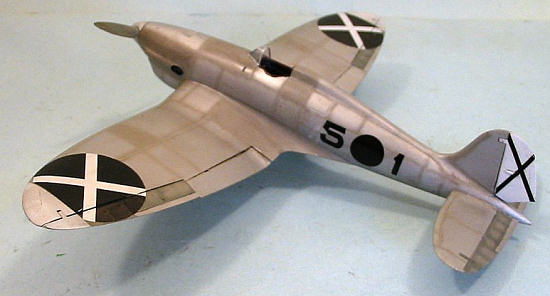 Construction is easy,
given that the fuselage and wing are molded as one-piece parts. As with other
resin kits from Rest, the quality of production and fit are excellent.
Construction is easy,
given that the fuselage and wing are molded as one-piece parts. As with other
resin kits from Rest, the quality of production and fit are excellent.
Construction begins with the cockpit, which is nicely detailed. I painted it in RLM02, with details in black, and used the photoetch instrument panel and seat belts. While the kit can be built with the cockpit side flaps down to show the interior detail, I decided to close these, because I wanted to emphasize the clean lines of the airplane.
I attached the separate flaps and ailerons to the wing, and glued that to the fuselage. I then attached the horizontal stabilizers and rudder, and then attached the radiator and its cowling.
| COLORS & MARKINGS |
While it was originally
thought that the He-112 V6 flew in overall RLM02,later research has revealed
that, while some areas of the airplane were painted with RLM63 Grey, most of the
airplane was in natural metal, with a thin, semi-transparent coat of either
RLM02 or RLM63. Other modelers have attempted to do this finish to models of
the three Bf-109 prototypes sent to Spain which had similar finish, but found
that the thin coat of RLM02 or 63 was very hard to create and apply in a smooth,
uniform finish. Essentially, what is really needed is a bottle of “clear”
RLM02, like the clear red, green and yellow colors from Tamiya and Gunze-Sangyo.
I decided to persevere and try to create this finish using Gunze-Sangyo “RLMO2"
- which is closer to the early RLM63 color, mixed with Future to try and create
my own “clear” color.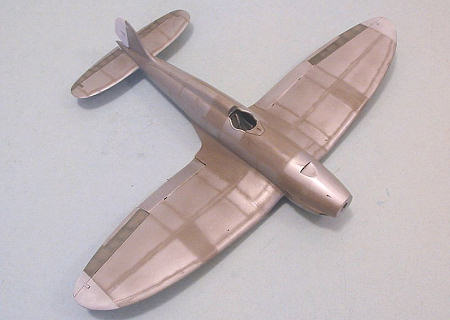
I first painted the model overall with SnJ Aluminum, with the fabric-covered ailerons in RLM02, done with Xtracrylix. I then freehanded Gunze-Sangyo RLM02 along the panel lines and over several different panels, per the few photographs of the He-112 V6 I could find. I then applied the “clear” paint. Unfortunately, it is virtually impossible to create a homemade “clear” color that will go on evenly. I didn’t like the result and at first I thought I would strip this paint with rubbing alcohol that wouldn’t harm the SnJ and start over. Then I studied the photos of the actual airplane and realized that the reason so many previous researchers had thought the airplane was painted overall in RLM02 was because this “clear” color also went on the original in an uneven manner, leaving a blotchy look that in a black and white photo could be mistaken for a worn RLM02 finish. Thus, I decided to leave things alone.
I painted the gear wells and the landing gear, including the doors, RLM02, since they appeared darker than the rest of the airplane in photos. I also painted the rudder and wingtips with Xtracrylix White. The prop blades were painted RLM02 while the spinner was painted with SnJ Aluminum.
Decals:
The kit decals are not particularly good. The only way I could get the wing insignia decals to settle into the panel lines was to slice them with an Xacto once they had set up, and apply more decal solvent over those areas. The decal for the cross insignia on the rudder broke up on application, so I ended up using some black striping decals from the decal dungeon to finish it.
| FINAL CONSTRUCTION |
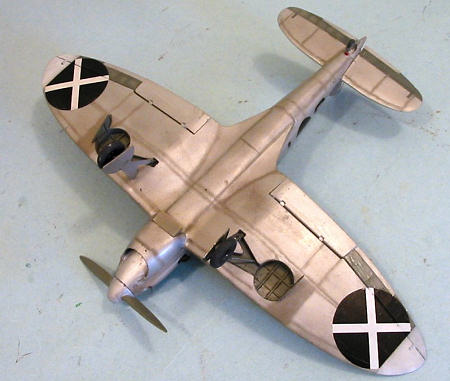 I gave the model an overall
coat of Xtracrylix Flat Varnish. I then assembled and attached the landing gear,
and attached the vacuform windscreen. I attached the prop and the model was
finished.
I gave the model an overall
coat of Xtracrylix Flat Varnish. I then assembled and attached the landing gear,
and attached the vacuform windscreen. I attached the prop and the model was
finished.
| CONCLUSIONS |
This is a very limited-run kit, and certainly not cheap at $70 retail. The He-112 V6 is a historically-important airplane, and should be of interest to serious Luftwaffe modelers. As a resin kit, the model is easy enough to assemble that a modeler who has not done a resin kit before should have no problem with this kit. Anyone interested in the aircraft of the Spanish Civil War will find this an interesting addition to any collection of Spanish Civil War airplane models.
Review Kit courtesy of Cooper Models. Get yours at: www.coopersmodels.com
November 2006
If you would like your product reviewed fairly and quickly by a site that has over 325,000 visitors a month, please contact me or see other details in the Note to Contributors.